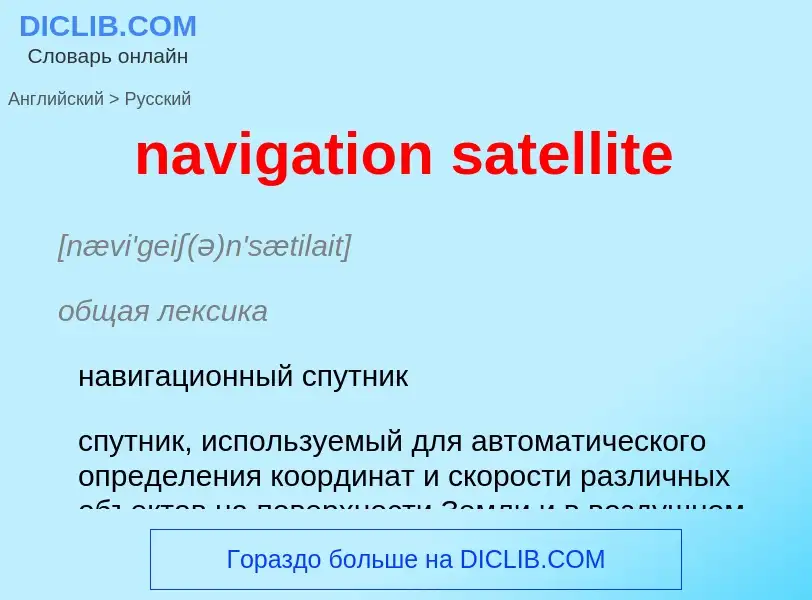Tradução e análise de palavras por inteligência artificial ChatGPT
Nesta página você pode obter uma análise detalhada de uma palavra ou frase, produzida usando a melhor tecnologia de inteligência artificial até o momento:
- como a palavra é usada
- frequência de uso
- é usado com mais frequência na fala oral ou escrita
- opções de tradução de palavras
- exemplos de uso (várias frases com tradução)
- etimologia
navigation satellite - tradução para russo
[nævi'geiʃ(ə)n'sætilait]
общая лексика
навигационный спутник
спутник, используемый для автоматического определения координат и скорости различных объектов на поверхности Земли и в воздушном пространстве
общая лексика
Global Navigation Satellite Systems
глобальная навигационная спутниковая система
Смотрите также
Definição
Wikipédia

A satellite navigation or satnav system is a system that uses satellites to provide autonomous geo-spatial positioning. It allows satellite navigation devices to determine their location (longitude, latitude, and altitude/elevation) to high precision (within a few centimetres to metres) using time signals transmitted along a line of sight by radio from satellites. The system can be used for providing position, navigation or for tracking the position of something fitted with a receiver (satellite tracking). The signals also allow the electronic receiver to calculate the current local time to a high precision, which allows time synchronisation. These uses are collectively known as Positioning, Navigation and Timing (PNT). Satnav systems operate independently of any telephonic or internet reception, though these technologies can enhance the usefulness of the positioning information generated.
A satellite navigation system with global coverage may be termed a global navigation satellite system (GNSS). As of September 2020, the United States' Global Positioning System (GPS), Russia's Global Navigation Satellite System (GLONASS), China's BeiDou Navigation Satellite System, and the European Union's Galileo are fully operational GNSSs. Japan's Quasi-Zenith Satellite System (QZSS) is a (US) GPS satellite-based augmentation system to enhance the accuracy of GPS, with satellite navigation independent of GPS scheduled for 2023. The Indian Regional Navigation Satellite System (IRNSS) plans to expand to a global version in the long term.
Global coverage for each system is generally achieved by a satellite constellation of 18–30 medium Earth orbit (MEO) satellites spread between several orbital planes. The actual systems vary, but all use orbital inclinations of >50° and orbital periods of roughly twelve hours (at an altitude of about 20,000 kilometres or 12,000 miles).




